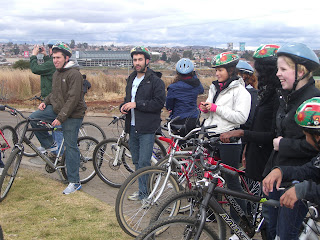After a riveting evening lecture on the Apartheid by UCT's Professor Charles Villa-Vicencio, what better a way to continue exploring different cultures than to dine at an authentic Turkish restaurant? Six among our group chose to do just that, and all were thrilled by the delectable supper experience.
A taxi ride into Green Point and a short walk down the street brought us to the heavily-mirrored entrance of Anatoli’s, a venue that Natalie Stein had discovered in a guidebook. More mirrors guided us into the main dining area, where our host seated us at a long table covered with white paper and lit, almost romantically, by a single candle. Promptly, our jovial server brought tall glasses of water and offered us a large tray that buckled under the weight of a smorgasbord of different appetizers, from which we eagerly selected a half-dozen dishes. Grilled cheese, potato pastries, octopus, meatballs—as we sampled our choices, we deemed the variety of flavors and textures marvelous. Meanwhile, the server slid sliced hot loaves of bread directly onto the table (hence the necessity of the paper covering), and we broke off chunks of this crispy staple to complement our appetizers.
Although several among us claimed that their stomachs were already satisfied up to this point, the best was indeed yet to come. Our appetites successfully whetted, the server invited us into the kitchen, where we saw samples of the available entrees—including mince-filled pasta shells, lamb stew, baked eggplant with pine nuts, and kabobs of several species skewered across daggers. Each person indicated which of the delicious-looking creations was most to their liking, and we waited at our table until the main course made its grand entrance. Words cannot accurately describe the incredible tastes we experienced as we savored our dinner, but rest assured that this food delivered to us an absolutely fantastic introduction to Turkish cuisine.
Full to bursting though we were, we simply could not resist indulging in the desserts that our server offered on another large tray. One baklava, one rice pudding, and one flan-like custard later, our group unanimously felt that we had completed our evening in one of the most savory and enjoyable ways imaginable. Exiting the restaurant and accepting the final, final ingredient of the experience—lokum candy—at the door, no words but praise and gratitude escaped our very content mouths.
-Michael Dawedeit



